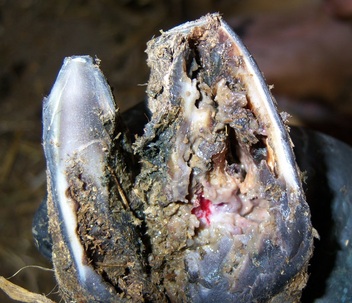
HOOF ROT
All livestock with hooves are prone to acquiring this bacterial infection, especially during periods of high moisture or humidity. It is a bacterium that spreads due to lack of oxygen and can have damaging effects on the animal’s feet/health. Hoof rot is caused by the softening and thinning of the inter-digital skin by puncture wounds or continuous exposure to wet conditions, which provides an entry point for infectious agents and bacteria.
Preventative Measures:
- Waiting to introduce new animals into the herd
- Manure free areas or dry footing
- Hoof checks/trims when needed

HOOF ROT IN SHEEP
The Signs:
- Lameness
- Elevated body temperature
- Swelling of the foot
- Separation of the skin
- Ulcers, abscesses, abrasion, fractures and inflammation
- Swollen around hoof with red irritated area
The Treatment:
Clean the areas to be certain lameness is actually due to foot rot, and use a topical treatment on the affected area. Consult a vet for severe cases and proper treatment/diagnosis.
For more information click on the links below:
Thrush
Thrush is an infection of the central and lateral clefts of the frog of a horses hoof. It is often bacterial and occasionally a fungal infection. This can be an easy fix if caught early, but can cause major damage to the animal if not treated.
The Signs:
- Lameness
- Soft hoof wall
- Foul smelling, black discharge in the frog of the hoof

Treatment:
- Clean the hoof regularly.
- Keep the hoof dry.
- Apply thrush treatment as recommended by your vet.
Preventative Measures:
- Clean the hoof regularly
- Dry footing/bedding and clean housing maintenance
- Regular farrier visits


